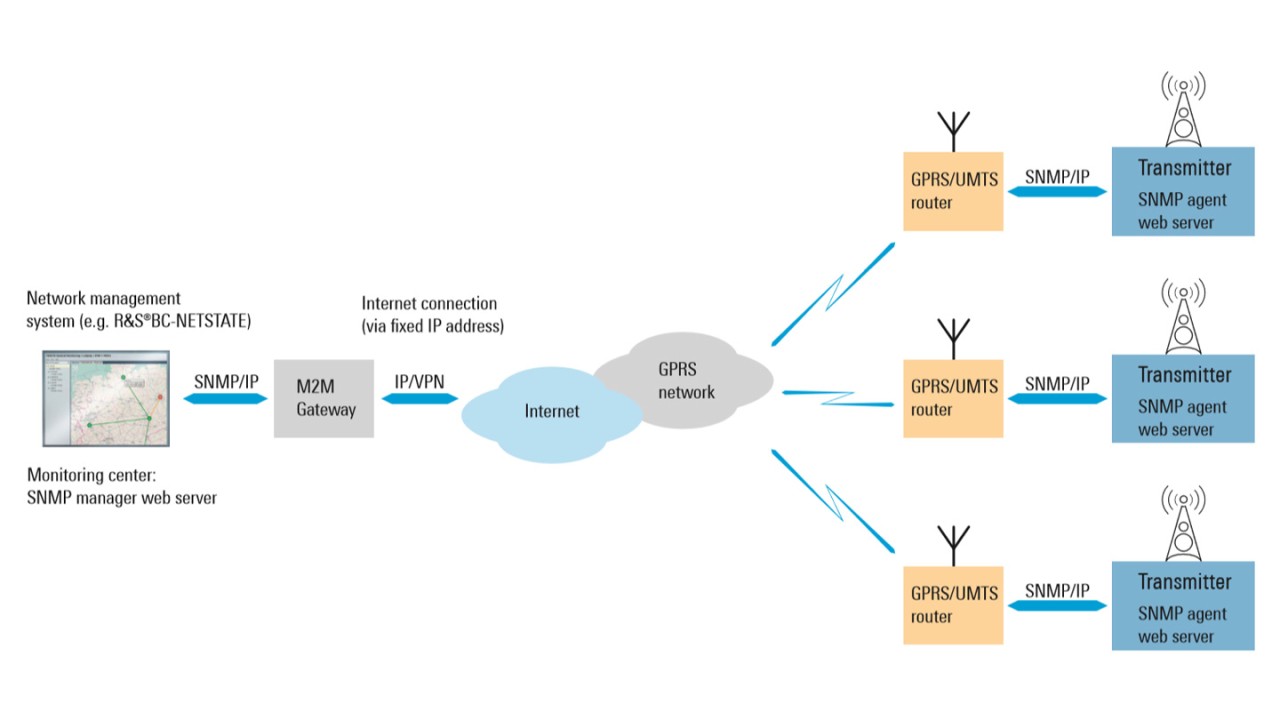Wireless remote control of transmitters
Remote control over a public mobile phone network with SMS or via a wireless IP connection.

Remote control over a public mobile phone network with SMS or via a wireless IP connection.
As a network operator, you must continuously stay informed about the current status of your transmitter system. Normally, wireline IP connections to the stations are used for this purpose to poll and control the facilities via the simple network management protocol (SNMP).
At some stations, the effort to lay cables for this remote control is too large. In particular for remote stations, e.g. in the mountains, an alternative to the wireline technology is needed. The use of the existing infrastructures of the local mobile phone operators is one solution. In particular, new broadband technologies such as GPRS or UMTS make it possible to implement convenient access to the transmitter locations.
If the transmitter needs to issue alarms or warnings, it may be sufficient for simple applications to send an SMS to various subscribers.
A GSM modem with a small built-in industrial controller is used for this purpose. Alternatively to SNMP, the transmitter can also issue alarms via a parallel interface. This interface has dedicated contacts for the individual alarm states and control capabilities.
The GSM modem must be configured that the alarm from
the parallel interfaces causes an SMS to be transmitted.
If network operators want to manage multiple alarms, or if multiple transmitters are located at the site, this solution quickly reaches its limits. Furthermore, this system is difficult to protect against outside attacks. Hackers can be successful at interfering with transmit operations. Moreover, alarms can hardly be recorded and evaluated.
If an SMS is triggered and the subscriber is, for example, on vacation, transmitter failures are unwillingly accepted. If the system transmits to multiple subscribers, they must coordinate among themselves to determine who will take care of the problem. Downtimes that are too long are also inevitable in this case. In addition, if the alarm states on the transmitter change continuously, a flood of text messages must also be expected.
A more flexible and safer method for setting up transmitter remote control is to install a TCP/IP link. The use of GPRS or UMTS routers and a corresponding gateway makes it possible to implement an IP link via a public mobile phone network.
The routers are installed on the stations and registered with the mobile phone network. The gateway is located at the monitoring center and is connected with the routers in the field via the Internet. An integrated VPN module provides access security.
After the setup of the link to the sites, the alarms of the transmitter can be scanned via SNMP or control commands can be sent. This task can be performed using, for example, the R&S®BC‑NETSTATE. The transmitter status is conveniently displayed, alarms are managed properly and control commands are issued.
Even if the transmitter fails, convenient HTTP access to the integrated web server is possible. All errors here can be analyzed by reading out the event log, for example.
Advantages
Since data links are often paid for according to transmitted data volumes and the alarm administration produces only a slight data volume, expenses are kept under control. The use of flat rates makes it possible to calculate the costs.
Moreover, a transmitter failure is often accompanied by higher costs because, for example, the failure of advertisement blocks can become extremely unpleasant for a network operator.

